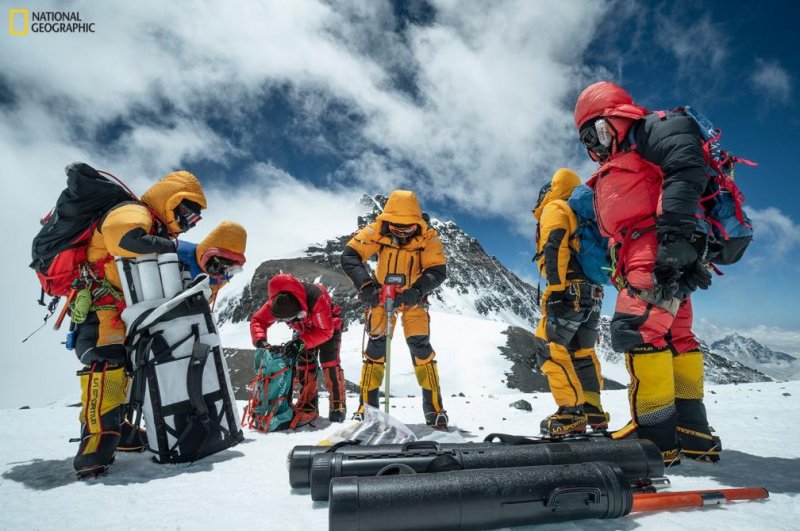Researchers collected ice cores from elevations as high as 26,400 feet above sea level during
the National Geographic and Rolex Perpetual Planet Everest Expedition
in the spring of 2019. Photo by Dirk Collins/National
Geographic
Nov. 20 (UPI) -- Mount Everest's glaciers are thinning, its peaks are accumulating microplastics and the air surrounding the mountain hosts more oxygen than it used to have.
Those are just a few of the findings from a suite of new studies -- each detailing various effects of climate change and human activity on Mount Everest -- published Friday in the journal One Earth.
Over the last few decades, human traffic on Mount Everest has steadily increased.
More and more people are visiting the mountain's basecamp each year, and more and more climbers are attempting to summit Earth's tallest mountain. As a result, pollution is accumulating.
According to the latest research, most of the trash is concentrated at basecamp, but scientists found microplastic pollution as high as 27,690 feet above sea level, not far from Mount Everest's peak.
Microplastic pollution in Earth's oceans has garnered a lot of scientific interest, but only a few studies have focused on microplastic pollution on land. The latest is the first to investigate microplastic pollution on Mount Everest.
During a few separate expeditions, researchers collected dozens of snow and ice samples to be analyzed in the lab.
"I didn't know what to expect in terms of results, but it really surprised me to find microplastics in every single snow sample I analyzed," first author Imogen Napper said in a news release.
"Mount Everest is somewhere I have always considered remote and pristine. To know we are polluting near the top of the tallest mountain is a real eye-opener," said Napper, a National Geographic Explorer and scientist based at the University of Plymouth in Britain.
Cleaning up microplastics is extremely difficult, but researchers suggest more can be done to ensure visitors to Mount Everest don't make the problem worse.
"The samples showed significant quantities of polyester, acrylic, nylon, and polypropylene fibers," Napper said. "Those materials are increasingly being used to make the high-performance outdoor clothing climbers use as well as tents and climbing ropes, so we highly suspect that these types of items are the major source of pollution rather than things like food and drink containers."
In a separate study, researchers used historic and modern satellite images to produce a timeline of glacier mass-change measurements. The data showed glaciers in the valleys surrounding Mount Everest have thinned by an average of 328 feet since the 1960s.
"The rate of ice loss in the region has consistently increased over the last six decades, and ice loss is now occurring at extreme altitudes," researchers wrote.
Rising temperatures have also led to increasing oxygen levels on Mount Everest, making it easier than ever before for climbers to summit the mountain without the help of supplemental oxygen.
Because air pressure decreases as elevation increases, oxygen becomes less concentrated as one gets farther from sea level. However, the rate at which air pressure decreases depends on temperature.
As global temperatures have climbed as a result of climate change, air pressure has increased on Mount Everest, yielding greater oxygen availability.
Much of the research detailed in the new collection of scientific papers was conducted during the 2019 National Geographic and Rolex Perpetual Planet Everest Expedition.















